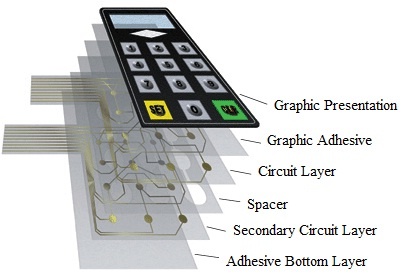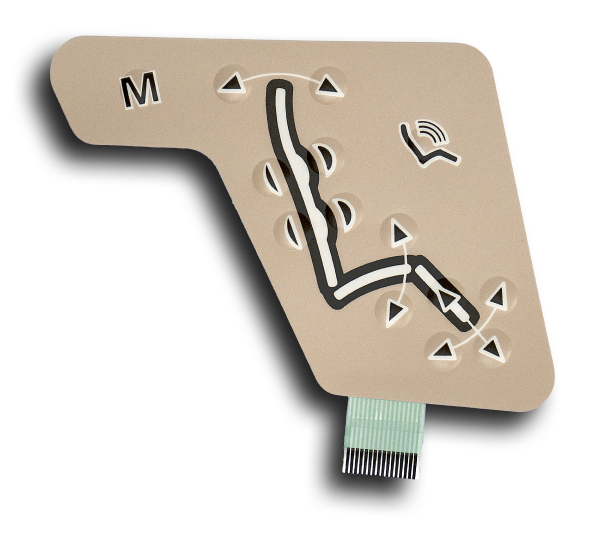All Concerning Membrane Switch: A Comprehensive Overview for Beginners
Membrane buttons are necessary elements in modern-day electronic devices, supplying a special interface for user communication - membrane switch. Their layered building and construction, consisting of overlays and conductive traces, offers performance and toughness. Unlike conventional mechanical buttons, membrane buttons offer a sleek style and personalized alternatives. Understanding their crucial functions and benefits can change item style. However, the intricacies of their application and style factors to consider require more exploration
What Is a Membrane Change?
A membrane layer switch is a kind of electrical switch that includes a versatile membrane layered over a printed circuit card. This layout enables for a sleek and portable user interface, often made use of in various digital tools. Membrane layer buttons are frequently discovered in consumer appliances, medical devices, and commercial equipment as a result of their toughness and resistance to environmental factors.The building commonly consists of numerous layers, such as visuals overlays and sticky backing, which supply tactile comments and protect the wiring underneath. The procedure of a membrane button is initiated when pressure is related to the surface, finishing an electric circuit.These buttons are valued for their convenience, making it possible for personalized layouts and printed graphics that cater to specific interface. Their inconspicuous nature lowers space demands, making them ideal for applications where traditional buttons might not fit. Generally, membrane buttons use a functional and aesthetic remedy for modern-day electronic devices.
Key Elements of Membrane Changes
Membrane layer switches over comprise several vital elements that add to their functionality and efficiency. The top layer, known as the overlay, provides the interface and is commonly published with signs or graphics. Beneath the overlay lies a spacer layer, which separates the conductive aspects and prevents unintentional activation. The next important element is the graphic layer, which boosts appearances and assures the resilience of the design.Conductive traces, usually made from materials like silver or carbon, are published on the circuit layer. When pressure is used to the overlay, these traces enter into get in touch with, completing the circuit. Additionally, a support layer provides structural support and can be made from materials such as polyester or polycarbonate. With each other, these components produce a reliable, straightforward interface appropriate for numerous applications, from house appliances to industrial devices. Recognizing these components is vital for any person curious about membrane layer switch modern technology.
Just How Membrane Layer Switches Job
Recognizing how membrane changes function is important for appreciating their widespread use in different tools. A membrane button operates via a series of layers, including a visuals overlay, spacer, and a circuit layer. When pressure is related to the overlay, it presses the spacer layer, enabling the circuit layer to make get in touch with and finish an electrical circuit. This action sends a signal to the tool, triggering a feedback, such as activating a light or activating a function.Membrane changes can be developed with numerous features, consisting of responsive responses, backlighting, and customized graphics, enhancing individual interaction. Their building allows for a covered style, safeguarding the inner elements from dirt, wetness, and pollutants. This durability makes them suitable for diverse applications, from customer electronics to industrial tools. Generally, the simplicity and efficiency of membrane layer switches over add to their popularity in contemporary technology.
Benefits of Membrane Layer Changes Over Mechanical Switches
While mechanical switches have actually long been a staple in numerous devices, membrane switches over offer unique benefits that make them significantly appealing. One substantial advantage is their slim account, permitting even more small designs and better flexibility in product growth. Additionally, membrane layer switches attribute an uniform surface area, which boosts visual appeal and streamlines cleansing, making them suitable for environments where hygiene is critical.Another advantage is their resistance to dirt and dampness. Unlike mechanical buttons, which can be endangered by environmental factors, membrane layer switches offer a closed interface that shields versus pollutants - membrane switch. In addition, membrane layer buttons usually have a longer life-span because of fewer moving parts, leading to improved sturdiness and reliability.Cost-effectiveness is additionally a noteworthy advantage, as membrane layer buttons can be produced in bulk with reduced production expenses. These variables combine to place membrane layer buttons as a practical option to typical mechanical options in various applications
Usual Applications of Membrane Layer Changes
Membrane layer buttons are commonly made use of in numerous industries, particularly in consumer electronic devices and commercial control panels. In consumer devices, they provide a sleek, easy to use user interface, while in industrial setups, they boost durability and capability. Understanding these applications highlights the adaptability and functionality of membrane switches in modern technology.
Consumer Electronics Tools
As consumer electronic devices proceed to develop, membrane layer buttons have actually come to be a preferred choice for a range of gadgets because of their versatility and sleek design. These buttons are frequently located in smartphones, tablet computers, and push-button controls, where room is restricted and appearances matter. Their reduced account and personalized designs permit producers to produce user-friendly user interfaces that improve the total customer experience. In addition, membrane layer switches are usually utilized in home appliances such as microwaves and coffee machine, supplying instinctive control choices while standing up to wetness and dust. The durability and integrity of membrane layer changes make them appropriate for everyday customer products, making sure long life and consistent performance. In general, their assimilation in customer electronic devices reflects a mix of capability and modern design.
Industrial Control Panels
The applications of membrane switches expand beyond consumer electronic devices, finding considerable use in industrial control panels. These buttons are preferred for their resilience and resistance to rough atmospheres, making them perfect for manufacturing and procedure control setups. They give a trustworthy user interface for operators to control equipment, monitor procedures, and change settings. Membrane layer buttons can be tailored to match certain operational demands, including functions like backlighting and responsive responses, enhancing customer experience. Their inconspicuous style enables integration right into numerous devices, while their capability to withstand spills, dirt, and severe temperature levels assurances durability. Overall, membrane layer buttons contribute to safe and reliable operation in commercial applications, showing their adaptability and performance sought after environments.
Factors To Consider for Creating Membrane Layer Switches Over
When creating membrane layer buttons, picking the ideal products is important to guarantee durability and capability. Furthermore, comprehending layer arrangement strategies can greatly impact the switch's efficiency and user experience. These considerations play a vital role in creating trusted and reliable membrane switch designs.
Product Selection Value
Material option plays a necessary duty in the layout and capability of membrane buttons. The selected materials directly influence the switch's longevity, tactile reaction, and overall visual. Key considerations include the substrate, which must supply architectural integrity while enabling for flexibility, and the graphic overlay, which requires to be immune to use and ecological aspects. Conductive products ought to ensure trustworthy electrical efficiency, while adhesives must use strong bonding without jeopardizing the switch's procedure. Additionally, compatibility with producing procedures and end-user atmospheres is crucial; products should withstand varying temperature levels, humidity degrees, and chemical direct exposure. Inevitably, appropriate material choice not only enhances the membrane layer switch's performance yet additionally adds to its long life and customer satisfaction, making it a look at more info critical element of the design process.

Layer Arrangement Methods

Often Asked Questions
For How Long Do Membrane Switches Over Commonly Last?
Membrane buttons usually have a life-span of 1 to 5 million cycles, relying on usage and ecological problems. Aspects such as layout top quality and operating regularity considerably affect their durability and overall performance longevity.

Can Membrane Switches Over Be Custom-made for Details Styles?
Membrane switches can certainly be tailored to suit specific styles, enabling diverse forms, shades, and capabilities. This adaptability enables makers to tailor these buttons to meet special visual and functional demands properly.
What Products Are Made Use Of in Membrane Switch Building And Construction?
Membrane buttons are typically created using materials such as polyester, polycarbonate, and glue layers. These materials offer versatility, durability, and resistance to ecological aspects, ensuring the buttons work efficiently in different applications and problems.
Are Membrane Layer Switches Resistant or waterproof to Dampness?
Membrane switches can be developed to be moisture-resistant, making use of specialized finishings and materials. However, their water-proof capacities rely on building and construction quality and details applications, making it essential to analyze needs for perfect efficiency in numerous settings.
How Are Membrane Layer Switches Repaired if Harmed?
Repairing broken membrane layer changes usually entails replacing the influenced layer or circuit. Technicians may likewise use conductive glue or make use of specialized fixing packages, making sure functionality is brought back without complete replacement of the entire switch setting up. Unlike typical mechanical switches, membrane buttons provide a sleek layout and personalized choices. A membrane layer switch is a type of electrical switch that is composed of a flexible membrane layered over a published circuit board. The procedure of a membrane switch is started when stress is used to the surface, finishing an electric circuit.These switches are valued for their convenience, making it possible for personalized layouts and printed graphics that cater to certain individual interfaces. While mechanical buttons have actually long been a staple in several devices, membrane switches offer unique benefits that make them increasingly appealing. Membrane layer switches typically have a longer life expectancy due to fewer relocating components, resulting in boosted toughness and click over here now reliability.Cost-effectiveness is likewise a notable benefit, as membrane switches can be produced in mass with reduced manufacturing prices.